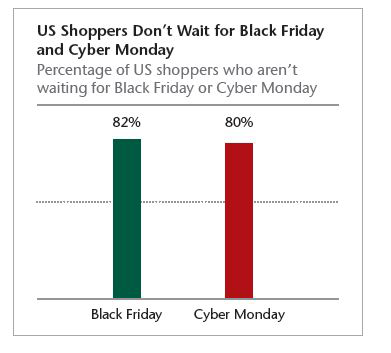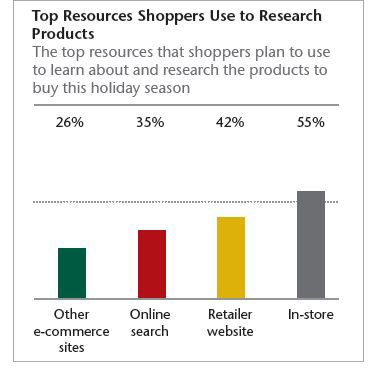Nice Knowing You Black Friday

Long lines, aggressive shoppers, limited inventory...gives you a warm and fuzzy feeling, doesn't it? Well, get it while it lasts.
For the second consecutive year, SDL - a software and services company - looked into consumer behavior and how people describe their experiences, specifically with the holiday season (an inforgraphic on the data is included at the end of this article). In its "Holiday Shopping Preferences 2013" survey, it was noted that the majority of U.S. shoppers aren't waiting for Black Friday (82 percent), Cyber Monday (80 percent) or other calendar milestones to begin their holiday shopping. Couple these findings with the fact that almost half of U.S. shoppers (49 percent) are shopping online to avoid the crowds, and we're likely seeing the imminent decline of Black Friday.
 Knowing that U.S. shoppers aren't waiting for these days to begin their holiday shopping, retailers should adjust their digital campaigns to focus on the overall experience, according to Senior Vice President of Marketing at SDL Rusty Warner.
Knowing that U.S. shoppers aren't waiting for these days to begin their holiday shopping, retailers should adjust their digital campaigns to focus on the overall experience, according to Senior Vice President of Marketing at SDL Rusty Warner.
"It's evident that people will leverage multiple channels on their way to a single transaction," said Warner. "They're going to engage with the brands at several points even for one transaction. Make sure the experience is consistent across channels, which is a better way to spend time rather than focusing on a particular milestone."
This is especially good advice, when looking at a few different data points from the survey. First, 73 percent of U.S. shoppers indicated they are willing to pay more for a product if the brand delivered a positive customer experience. Secondly, 81 percent of U.S. shoppers expect a consistent experience from mobile to laptop to in-store.
When discussing cross-channel shopping, showrooming is a topic that can't be ignored. For the unfamiliar, showrooming is the act of visiting a brand's physical location only to evaluate products and then buying online at another time.
In the past, SDL has found the "showrooming" trend very relevant and a key piece of how consumers interact with retailers and their products. More than half of the holiday respondents this year are researching products they want to buy directly in the store (55 percent). This is a more common research option than the use of online tools like retailer websites (42 percent) and other ecommerce sites (26.3 percent). However, in the United States in 2012, online search was by far the most used resource for learning about and researching holiday gifts to purchase, according to the report.
This year, in the U.S., however, in-store was the preferred researching tool, edging out online activity (retailer website, other ecommerce sites and online search). Showrooming is alive and well!
Social media, on the other hand, is "bleh" at best. SDL's survey shows that people aren't going to social to get information.
 Only 2-3 percent of global shoppers used Pinterest or Twitter to learn about products in 2012 and 2013. Facebook and Google+ are the most popular channels for global shoppers to learn about products, but they hover between 5-8 percent in 2013 and 2012 respectively, according to the report.
Only 2-3 percent of global shoppers used Pinterest or Twitter to learn about products in 2012 and 2013. Facebook and Google+ are the most popular channels for global shoppers to learn about products, but they hover between 5-8 percent in 2013 and 2012 respectively, according to the report.
There's obviously a disconnect between what brands are putting on social and what consumers want from the networks. Warner sees brands doing two things wrong. One, they are focused on advertising-type messages and people don't go on those sites to be marketed to. Secondly, marketers are putting their metrics in the wrong place. Warner says they are happy that they got a number of likes, or followers, but those are vanity metrics.
Instead of posting a picture of a dancing cat to get Facebook Likes, Warner advises brands to make content relevant and appropriate to the channel, building loyalty in the process.
SDL created this infographic highlighting the data from its holiday survey:








